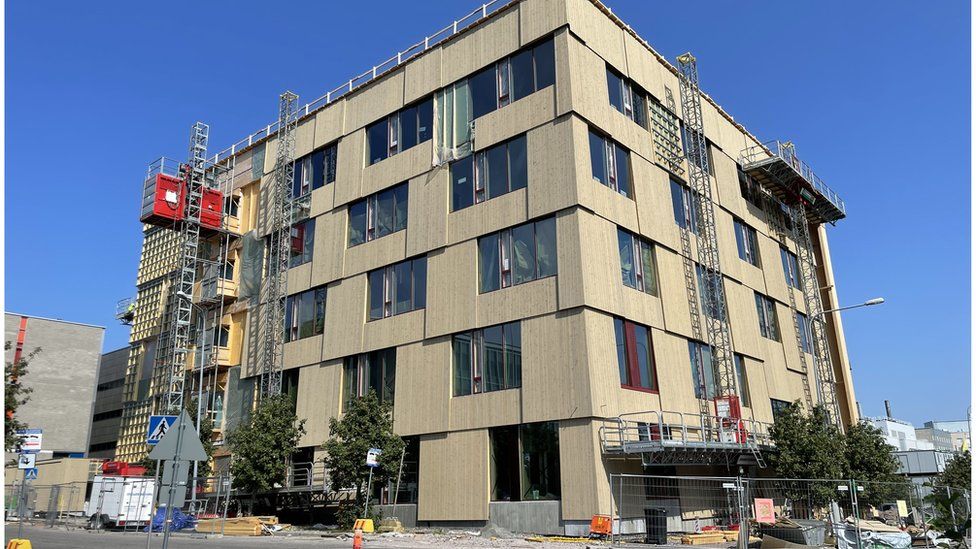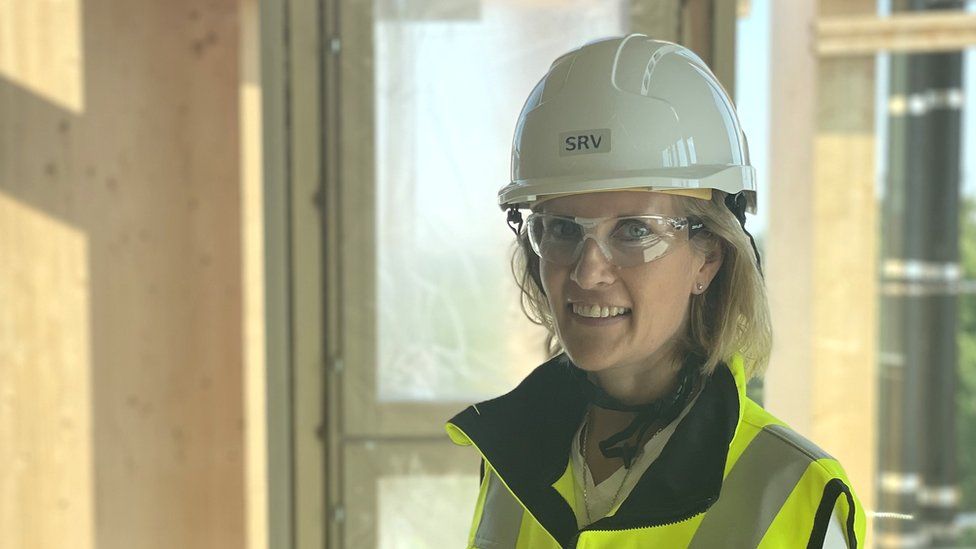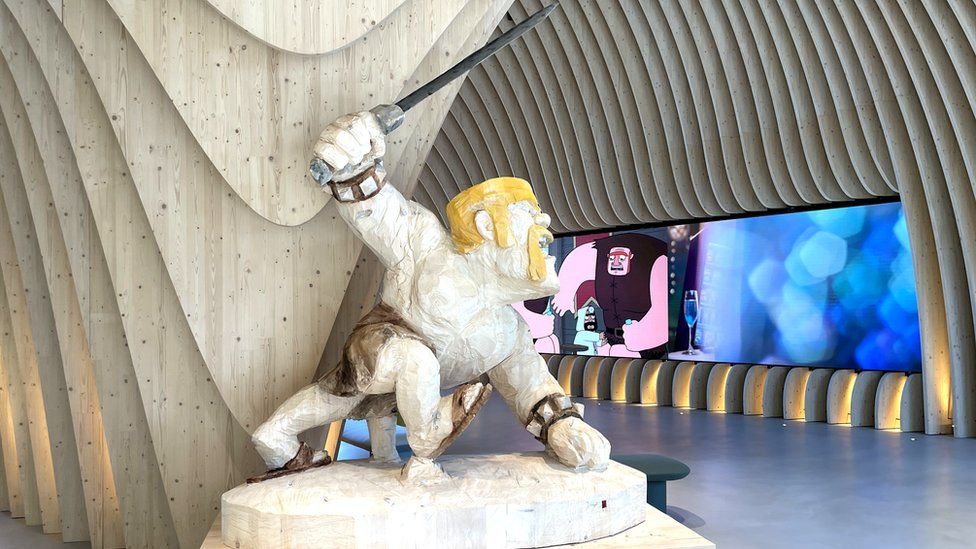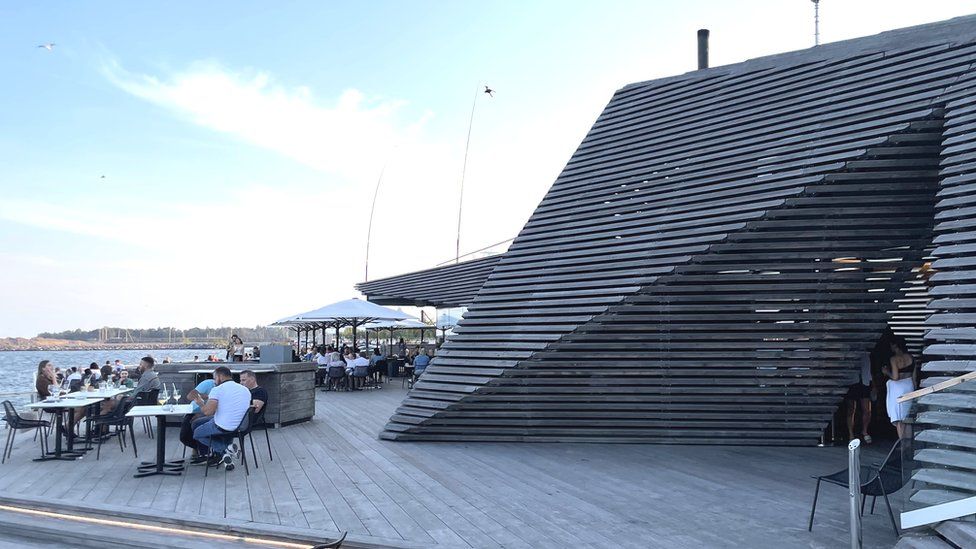Is Finland’s Wood City the future of building?
 Maddy Savage
Maddy SavageIt smells like a lush pine forest in the lunch room of a new upper secondary school in Helsinki, but there’s no scented air freshener.
Instead, most of the five-storey building has been constructed out of wood.
The school won’t be completed until next year, although smooth wooden panels already line many of the interior walls. Wood has also been used in load-bearing structures, to support the ceilings between the floors, and as cladding on the exterior.
“It’s a more sustainable choice,” says Miimu Airaksinen, an engineer and vice president of development at SRV, the Finnish construction company behind the school.
“But we’re also working with wood because wood is a nice material, people appreciate and like wood and the design of wood.”
The project is part of a growing trend in the Finnish building industry. Developers are increasingly swapping out more mainstream materials like concrete and steel, in favour of wood. It’s linked to the country’s ambitious efforts to achieve carbon neutrality by 2035 and become Europe’s leading circular economy.
With three-quarters of land in Finland covered by forests, wood is a readily available material here, although it does need to be strengthened for use in mid-rise and tall buildings.

In Finland, where detached wooden villas and summer cottages are common, there is less public concern about fires than there might be in parts of the world that are less used to using wood as a construction material.
However, SRV still faces questions about flammability, especially in taller buildings. There is plenty of evidence that CLT performs well in fires though, says Ms Airaksinen, since it is designed to withstand high heat levels and can be slower to collapse compared to concrete.
At the upper school construction site, Ms Airaksinen’s team are busy slicing up slabs of engineered wood called CLT (cross-laminated timber) which is produced by bonding together layers of wooden panels at right angles. “You’re making the wood stiffer, so that makes the wood much stronger,” she explains.
Engineered wood like CLT has a range of environmental benefits, including being much lighter than many building materials, so less heavy machinery and energy is needed during construction. Buildings can also be quicker to complete since there is no drying phase as there is with concrete.
Plus, wooden buildings actually remove more carbon dioxide from the atmosphere than they emit; they can hold in carbon that is absorbed from the atmosphere by trees for five to six decades. By contrast, steel and concrete leave massive carbon footprints.
“It can really help us with climate change,” says Ali Amiri, a sustainable buildings researcher at Aalto University near Helsinki, and a former civil engineer.
“If we go through the comparison with wooden buildings and other buildings like concrete or steel or even brick buildings, [wood has] something like 20 to even 30% lower greenhouse gas emissions. So this is very good news.”

According to his team’s research, if 80% of new residential buildings in Europe were made of wood they could store up to 55 million tonnes of carbon dioxide a year. That is equivalent to almost half the yearly emissions made by the continent’s cement industry.
Engineered woods like CLT have been used in Europe since the 1990s, but they have had a resurgence in Finland thanks to a government-backed wood-building programme designed to ensure 45% of public buildings use wood as a key material by 2025. Developers can apply for grants and get help with tasks such as procurement and risk communication. “I think every company [here] is doing wooden buildings today,” says Ms Airaksinen. “The pressure is on for sustainability.”
At the upper secondary school, gypsum board, which is made from limestone and not flammable, is used to add an extra layer of protection on the interior walls on higher floors. “We need to take fire safety seriously,” says Ms Airaksinen. “We also did a lot of simulation about evacuation and durability in case there will be a fire.”
The wooden trend is catching on in the private sector too. Data from the Federation of the Finnish Woodworking Industries suggests it is already a key material in 4% of apartments and 16% of commercial buildings.

In Helsinki city centre there’s even a new neighbourhood, Wood City, with hundreds of new wooden flats.
It is also home to the headquarters of Finnish gaming giant Supercell, where huge carved wooden characters and dramatic curved panels make for an impactful reception area, and wood lines the walls of eight storeys of open-plan office space, cafes and even nap rooms.
Cybersecurity company WithSecure is in the process of building a new office next door, in collaboration with SRV and Stora Enso, a major Finnish producer of engineered wood.
And, perhaps least surprisingly, in a country where people famously love getting sweaty, one of Helsinki’s most popular leisure attractions is a giant wooden sauna and restaurant complex. Opened in 2016, the Löyly complex has won multiple global awards for its striking wooden cloak-like structure, which allows visitors to climb up its sloping roof.

Environmental campaign groups such as WWF have raised concerns that increasing the construction of wooden buildings could put too much pressure on the planet’s forests.
“From a climate perspective it is a good way to store carbon, but on the other hand we are increasing the overall level of consumption of natural resources,” says Mai Suominen, a leading forest expert for WWF. “Because obviously we do need other wood-based products as well, such as paper or packing material, [and] if we plan to increase other production, we are increasing the level of cutting.”
Finland’s wood production companies have committed to replanting logged areas in a sensitive and sustainable way. However, Ms Suominen argues that there is still a risk of lower biodiversity if production ramps up in future, which could have an impact on both animals and humans.
“Then the forest processes, at some point they collapse and they are not as flexible to responding to changing environmental conditions caused by climate change. We will face more rainfall, more drought and insect outbreaks.”

Sustainability expert Nani Pajunen from the Finnish Innovation Fund, Sitra, agrees it is important that construction firms in Finland and beyond don’t simply jump on the bandwagon of the wooden buildings trend in an effort to appear greener.
She argues it is more important that businesses make broad assessments of the carbon footprint of their production processes, and the different life cycle potentials of materials.
For example, other recent innovations designed to improve sustainability in the sector, such as recyclable concrete and steel, might be more durable than wood in large-scale projects such as very tall apartment blocks, public venues or bridges.
“It’s not a black and white question of which [materials] are wrong and right,” she argues. “It’s about the attitude. You have to think, if you are an engineer in the construction sector, how to use materials in a more sustainable way.”
Despite the environmental concerns, the wooden buildings sector is growing, with other Nordic countries, Germany, Canada and the US in particular ramping up their production in the last couple of years.
Market research company Fortune Business Insights recently valued the CLT market at $806m (£715m) and predicted growth of 14% by 2028.
In the wake of the Ukraine war pushing up the global cost of steel and energy, Mr Amiri says his research team has also noticed a spike in enquiries from businesses and decision-makers from around the world.
While Mr Amiri predicts wooden building construction will “definitely increase” in Europe and North America in the coming years, he points out that building with engineered wood for multi-storey projects is still “a bit more expensive” than using more common materials. This, he argues, might make it harder to persuade countries with access to cheap concrete and steel to switch direction.
Back amongst the forklift trucks and diggers continuing to transform SRV’s school construction site, Ms Airaksinen says she envisages the wooden building sector increasing in tandem with the development of new low-carbon materials.
“We are focusing on building sustainable buildings and lifecycle wise buildings,” she says. “That’s the future.”

